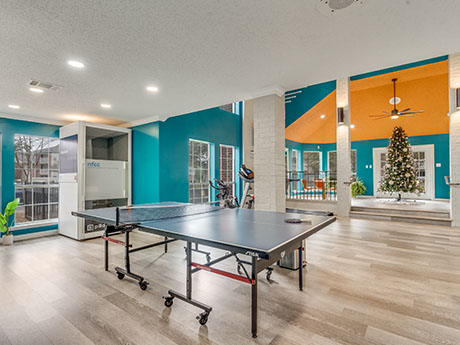By Antonio Marquez, managing partner, Comunidad Partners
Amenities are important when it comes to renter appeal. However, what residents want from their apartment complexes is based on different issues, like socioeconomic status.
Indeed, a resort-style pool, yoga rooms and fitness centers are nice. But residents at properties owned by Comunidad Partners, an operator of workforce housing communities across Sun Belt markets, want more than these features in their community.

To understand our residents — our customer base — we asked them questions, tried programs and obtained feedback. From this, we determined that our residents’ top three concerns were health, community safety and managing finances. However, expense management didn’t involve debt restructuring or financial literacy. Instead, access to the financial system was the issue.
Thanks to this feedback, we’ve developed and are implementing programs at two of our properties in Texas — Villas at Alameda in Fort Worth and the Villas at Shadow Oaks in Austin — to help residents access financial services like high-interest savings accounts. These intangible amenities help build and enrich communities while strengthening resident retention and other operational factors that benefit investors.
Sensing Residents’ Priorities
In determining the right amenities to support residents, it’s essential to understand your community.
For instance, many residents at Alameda are diverse indvididuals who work hourly jobs. Residents at Villas at Shadow Oaks are median income workers or students who are looking to save for their futures.
It’s also vital to dispel assumptions about residents who live in affordable housing. These assumptions might include being unemployed, only having access to low-paying jobs, being heavily in debt or struggling to make ends meet.
Here’s the reality:
• Less than 5 percent of our residents are unemployed, while 65 percent are on the “financial edge.” This means that an unexpected expense like a medical emergency or car bill could put them in serious financial trouble.
• Affordable housing residents are financially literate. They are outstanding at budgeting; they know exactly, to the dollar, what’s coming in and what’s going out.
• Contrary to popular belief, they aren’t overburdened with debt. The background of most of these tenants is to use the money on hand to buy rather than running up balances on credit cards.
Another reality is that affordable housing residents lack access to financial resources. Specifically at our properties, 10 percent are financially stable enough to buy a house or move to a larger apartment. However, this group can’t access capital markets (for savings) or mortgage brokers (to finance the purchase of a home).
Additionally, many of our residents are self-employed entrepreneurs. They need additional capital to expand their businesses but don’t have access to the necessary networks.
Finally, cultural backgrounds and previous experiences have generated mistrust of traditional financial institutions. In outlining issues of racial equality and housing finance, Fannie Mae reported a considerable gap between black/Latino and white homeownership, as well as barriers to affordable, stable rental housing among minority groups. Much of this is due to a lack of inclusion and increasing home prices.
Meanwhile, a study from the Brookings Institute found that 46 percent of Black Americans and 32 percent of Hispanic Americans are unbanked or underbanked, respectively, compared to 14 percent of white Americans.
Providing Solutions
Rather than focusing on financial education, the central issue for these residents is actually financial access. Based on the data and feedback, we were able to launch appropriate programs in Fort Worth and Austin which tackle the matter head-on.
Because residents have encountered with savings and borrowing obstacles in the past, partnering with financial advisors and institutions can help break down those barriers. These experts can help residents gain access to and set up high-yield savings accounts and credit lines. They also work with residents to find mortgages.
For our residents, we have found it valuable to partner with experts who are bilingual to help facilitate a deeper understanding of such financial systems. These partners and professionals do more than offer products or advice. They also break down the cultural mistrust of banking and finance, offering a way forward to help residents build emergency funds and savings.
Workforce housing residents typically work day jobs and cannot take off an hour or two to visit a financial advisor or broker in the middle of the day. Doing so could mean a hit to their paycheck.
An onsite “phone booth” solution we launched in Austin connects residents with experienced personnel during more convenient times. This secure location works by scheduling meetings with bilingual financial counselors during the early morning or evening hours.
The Benefits
The financial programs offered at Villas at Alameda and Villas at Shadow Oaks might seem counterintuitive to owners and operators of affordable housing properties. After all, if a resident can save for a larger apartment or put a down payment on a home, he or she won’t be a resident anymore.
Again, this is a myth. Certainly, when residents have the means, they may move out for more space or to purchase a home. But they stay while they’re getting their financial houses in order. In addition to clean, safe, affordable housing, access to financial services is a powerful incentive for them to remain in place.
Our residents stay for an average of three years. And while they’re here, they are stable neighbors. They invest in the community, keeping it safe and secure. That safety and security help attract new residents when the current ones move out and move up.
From a community perspective, it helps meet the priorities of residents, so they achieve their financial goals. From a bottom-line standpoint, this programming maintains a steady cash flow for investors.
Priorities Lead to Amenities
In closing, determining the right amenities for properties shouldn’t focus on what the developers or operators think residents want.
Instead, this process should aim to uncover residents’ pain points and develop specific programming that provides personal solutions that strengthen the overall community.
Further, this programming shouldn’t be based on assumptions. Instead, it should be based on what residents face and how amenities and programming can help make their journeys — and lives — a little easier. Doing this helps reduce turnover while supporting consistent returns.


